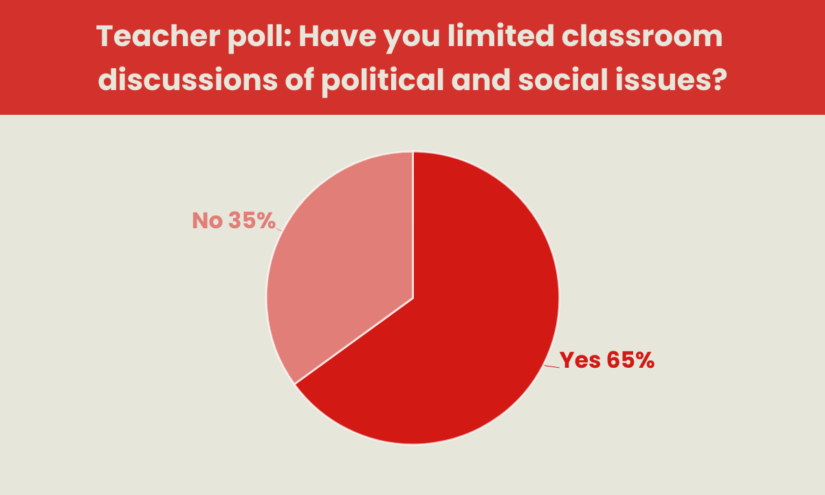During this summer, a team of students from MIT embarked on a journey to the sou …
Study Finds That 66% of Teachers Self-Censor Without Necessity
Jennifer Livingstone

Approximately two-thirds of teachers in the United States limit discussions on political and social issues in their classrooms, even in communities where there are no laws or policies prohibiting instruction on sensitive topics like race, gender identity, and sexual orientation, according to a new survey conducted by the RAND Corp.
What this means is that there are actually twice as many teachers who have voluntarily restricted their own classroom speech compared to those who are legally barred from discussing what some critics consider “divisive concepts.”
According to the report, this is the first time that researchers have measured what they call a “spillover effect,” which causes educators to self-censor even in communities that traditionally support such discussions, says Ashley Woo, one of the authors of the study.
According to RAND’s findings, a major reason why teachers engage in self-censorship is the fear of facing backlash from parents, regardless of the legality of their instruction.
“Oftentimes, it’s a really mobilized, very vocal minority of parents in a community,” says Woo. “Not only can parents come up to you and have a verbal altercation, but there’s also this idea that they can threaten your reputation through social media, or that they might be able to go to your leaders and threaten your job. … Even the specter of that can create a lot of anxiety for teachers.”
More than one-third of the 3 million teachers in the United States live in states that have enacted laws restricting their speech on topics related to race, gender, and LGBTQ issues. However, even in states without these laws, teachers are just as likely to face restrictions at the school or district level, according to the survey. Some teachers have stopped discussing controversial topics, such as abortion rights or climate change, while others are unsure about which subjects have been outlawed and therefore avoid teaching about historical figures of color or civil rights.
Among teachers who are not governed by any state or local restrictions, 55% have still chosen to modify their instruction. Educators in conservative communities without formal speech constraints are more likely to avoid discussing social and political issues. On the other hand, approximately 40% of teachers in politically liberal places, where no restrictions exist, have limited their instruction.
“Those are the kinds of communities where probably parents actually want and support those kinds of conversations in the classroom,” says Woo. “These are not voters who voted for the leaders who are putting these kinds of policies in place. These are not communities that want these restrictions in place.”
The findings of the survey align with recent research conducted by the free speech organization PEN America, which estimates that laws restricting educator speech impact 1.3 million K-12 teachers and millions of students. The “spillover effect” identified by RAND indicates that the actual number of individuals affected is even higher.
The data for the survey was collected from RAND’s 2023 State of the American Teacher Survey, which included a nationally representative sample of 1,439 K-12 teachers in January and February 2023. The political leanings of the communities were determined by analyzing voting patterns in the counties where the teachers reside.
Regardless of their reasons, teachers cited several factors that influenced their decision to alter their curriculum and instructional practices, including the fear of angering parents, a lack of guidance or support from school administrators, and concerns about job security and licensing. Some teachers mentioned hearing about disciplinary actions taken against educators in other locations for engaging in controversial discussions.
In some cases, local guidance to teachers may not be in the form of a formal policy but rather implicit instructions from principals. “Teachers may take that and be, like, ‘Okay, well, I guess I shouldn’t be talking about that, then,'” explains Woo.
Around 49% of teachers, regardless of their location, expressed concerns that their superiors would not support them if parents complained, which was one of their top three reasons for choosing self-censorship. Some teachers reported that school or district leaders had instructed them to avoid certain topics due to community pressure, while others stated they had received little to no guidance.
Supporters of restrictive laws argue that parents should have more control over what their children are exposed to in school. They claim that discussing “divisive concepts” puts pressure on students to conform to a particular ideology and infringes on the free speech rights of those who disagree. Public opinion polls consistently show minimal support for limiting instruction about race but varied opinions on whether and when students should learn about LGBTQ history.
Protests in many communities in states where there is limited political support for restricting instruction have led to disruptions at school board meetings and threats against educators and curricula that are perceived as promoting “indoctrination.” Numerous board members and district leaders have resigned due to harassment.

